 | 







 |  |

 |  |  | 
 Documenting the most ambitious and original designs of the 2000 season. Documenting the most ambitious and original designs of the 2000 season.
Below: The finale of the 2000 crop circle season was created at Woodborough Hill on 12 August. It is one of the most complex and geometrically rich patterns to ever appear. It sat nested between Picked Hill and Woodborough Hill close to Alton Priors and Alton Barnes. Being only a short half hour walk from that infamous circles HQ 'The Barge Pub'. It is rumoured that there were researchers camped out on Woodborough Hill the night the formation was made. This is a popular spot for sky watching, with a spectacular view of the Pewsey Vale and Salisbury plain. This wouldn't be the first time that circles have been made in close proximity to researchers - but circlemaking in a field that is being watched does add an edge to the proceedings.
[ Images The Circlemakers ]

 
We managed to grab a lift from a passing helicopter to get these images. The formation measured 250ft in diameter and was composed of over 300 individual standing triangles that were arranged around a set of 13 concentric rings. The triangles created an effect of spiralling curves which crossed and overlapped. In this respect its geometric structure had similarities to the Moire formation below.
The Woodborough formation also had the ummistakable geometric imprint of various natural forms, such as a sunflower seed head, pine cone etc. This template is created by interlocking fibonacci spirals. It follows the the pattern of recent crop circles that depict mathematical sequences that generate natural forms. The Fibonacci curve is also a proto fractal. It is self similar at any point down its curvature.
The mandala-like qualities of the Woodborough formation were also in evidence in the beautiful formation at Martinsnell Hill near Clench, only five miles away from Woodborough. See below:
[ Image The Circlemakers ]
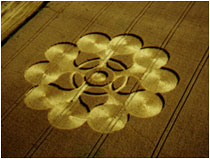
This formation clearly resembles a lotus flower. The source of much religious art in the East. From the image it is obvious the formation had the kind of geometric structure that one would associate with a lotus image. Underpinned by several nested pentagons it was another example of natural forms depicted using sacred geometry.
[ Images courtesy Peter Sorenson ]
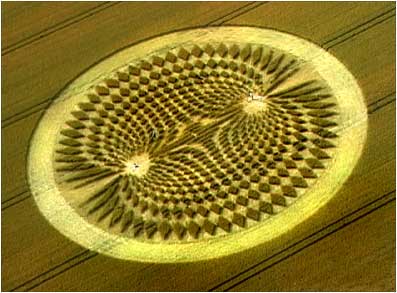
The formation above, resembling optically dynamic Moire rings appeared on the 22nd July at Avebury Trusloe, barely two miles from Avebury Henge. The geometry of this formation owes much to the previous grid design at East kennett [see below]. It is similarly constructed from a series of straight lines, creating a chequer pattern. In this formation there are 120 radiating lines that converge at 60 equidistant points. The convergence and intersections create the chequer pattern. Every alternate chequer has been flattenned creating this mind boggling design. The chequers optically create the curves.
So far opinion on this circle is unaminous, both from circlemakers and researchers: It is one of the best designs to be executed for several years.
On the ground the crop is laid radially from the centre points outwards, looking like a mini explosion. This lay was famously perfected by those great circlemakers and artists, Doug Bower and Dave Chorley. Some of their most effective simple formations were plain circles with magnificent radial lays.
The formation also resembles energy distributions at oppposite magnetic poles, and in doing so continues a tradition of crop formation designs which both reference mathematical principles and their geometrical equilavent that is found in natural forms.
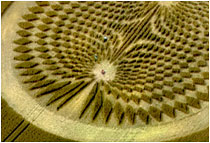


For sheer confusing complexity this design tops even the East Kennett grid formation.
The formation below is probably one of the most novel ever to appear. Based on another classic Doug Bower and Dave Chorley design the quintuplet or celtic cross. In most similar formations the central element would have been a flattened circle. Here the circlemakers have used the tumuli as the central feature. A case of both the formation and the circlemakers interacting with ancient landmarkings in a very literal and rather extraordinary way.
[ Images courtesy Peter Sorenson ]
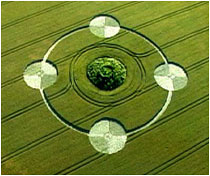


The lay on this Celtic Cross style formation [above] also picks up another one of Doug Bower and Dave Chorley designs. On each of the four circles the crop is laid in quadrants. In each quadrant the crop is laid at ninety degrees to the adjacent quadrant. This type of lay was first made by Doug and Dave in 1989 at Winterbourne Stoke. It so impressed researcher Ralph Noyes that he put it on the front cover of his 1990 edition of the Crop Circle Enigma. Over a decade later contemporary circlemakers have added a new dimension to a classic design.
[ Image courtesy Steve Alexander ]
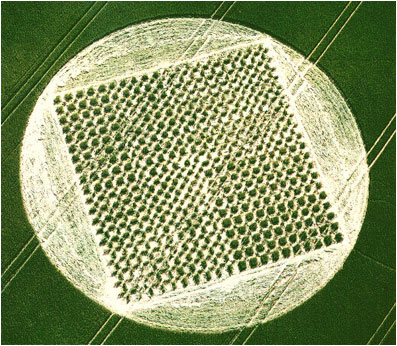
Overnight on Sat 1 July the formation above was created at East Kennett. Very close to Silbury Hill, East Kennett Longbarrow and West Kennett Longbarrow. Right in the heart of crop circle territory. The formation consists of 1600 rectangles of varying sizes arranged in a grid pattern, which is enclosed within a circle of 200ft.The grid appears to be optically shifting from darker standing squares to lighter flattenned squares.





[ Images courtesy Peter Sorenson ]
The geometry of this formation is flawless and the lay comprises of bands of crop woven between the standing clumps. The design is related to some of last years square based geometries, particularly the formation at windmill hill in 1999.
However this formation is unique in it's use of the grid. It is probably one of the most complex and precisely executed designs to appear in the region.
As can be seen by the aerial photograh above it was situated adjacent to another crop marking of natural origin. Here the crop has been discloured by the submerged remains of an ancient site, possibly a tumuli or something similar. These crop marking are relatively common in wiltshire but can only be seen from the air.
After siiting in the field for nearly two weeks it became the subject of a flurry of media reports [ see media con-struct for the full story ].
The same day, 1 July, the formation [ below ] was found beneath Milk Hill, famous for it's chalk white horse. Milk Hill lies about 4 miles due south of East Kennett, and very close to the well known East field.
[ Images courtesy Steve Alexander ]
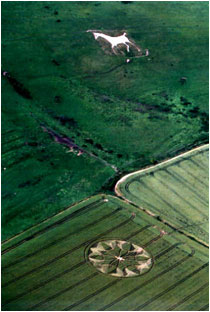


The formation comprises of circular geometry, bisected symmetrically to create a flower type effect. The floor lay of the crop was also particularly impressive, as the photographs [ above ] show. The lay of the crop follows the contours of the petals and ring enclosing them. The directional lay of this flattened crop reflects the light creating a shimmering effect.
[ Image courtesy Michael K ]
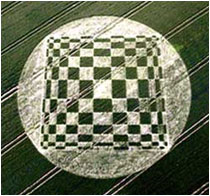
The seasons hotting up and as of today [ June 24th ] we now have 26 formations and counting in and around Wiltshire. Last weekend saw the appearance of two spectacular formations within half an mile of each other. One formation was located next to Windmill Hill [ above ] and the other at Bishops Canning in Wiltshire.
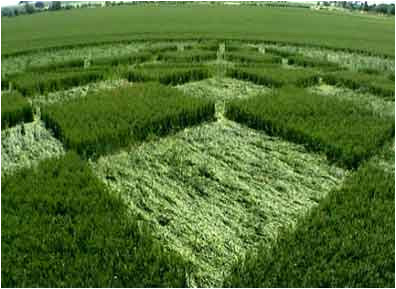
Windmill Hill has been host to several formations over the years, including the breathtaking 'Triple Julia Set' of 1996. This years formation literally jumps out at you, as it consists of a distorted grid of alternate standing and flattened crop creating an optical illusion which from the air makes the formation seem to bulge out from the earth. The formations is in immature wheat and is just shy of 300ft in diameter. Crop circle researcher Charles R Mallett described the formation as "the most stunning optical illusion the circlemakers have yet come up with... this formation is simply stunning, this sucker pops right out of the ground at you."
[ Images courtesy Peter Sorenson ]
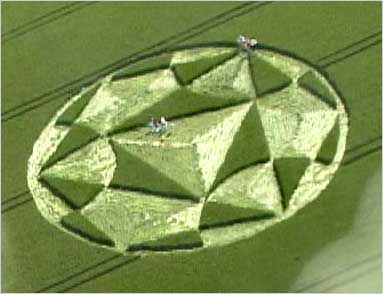
The second formation at Bishops Canning [ above ] is also in immature wheat. It's significantly smaller than it's near neighbor, measuring just under 200ft in diameter, but both the design and lay of the crop are exquisite.
[ Images courtesy Steve Alexander ]



These two formations appeared right next to the well known Waggon and Horses pub adjacent to the A4 road, very close to Silbury Hill. They were both discovered on 11th June.
The geometric template of both formations is linked to the square.
The first formation is a plan view of an octahedron, an eight sided platonic solid figure which in orthogonal projection creates a square.
The second formation is a star created from two rotated squares, generating a sixteen sided figure. For a full report see the Crop Circle Connector
 Last year a formation was created nearby at Overton with a geometric template that resembled an unfolded octahedron. Clearly a precedent for these two formations.
Last year a formation was created nearby at Overton with a geometric template that resembled an unfolded octahedron. Clearly a precedent for these two formations.
[ Images courtesy Peter Sorenson ]
 
A week or so earlier in the season the formation above appeared just below West Kennet Longbarrow, opposite Silbury Hill. This formation is remarkable in that it was constructed in two nights. An occurence that is very rare, and dangerous for circlemakers on their return visit. Risking stumbling over sightseers intent on spending the night in the fresh formation. The most well known two nighter was the spiders web, created adjacent to the Avebury Henge about a mile away in 1994. The Crop Circle Connector has a detailed field report.
[ Image courtesy Andrew King ]
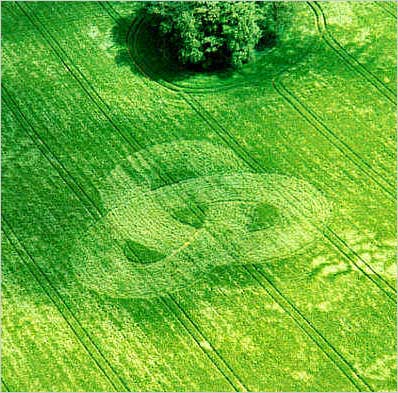
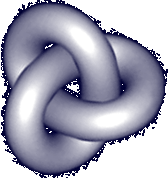 Well, we've had a very sedate start to the season this year, but things are now hotting up, so we've opened our 'top of the crops' gallery for 2000. Well, we've had a very sedate start to the season this year, but things are now hotting up, so we've opened our 'top of the crops' gallery for 2000.This stunning formation in Barley was discovered at Wrotham, Kent on the 14th May. It depicts a faux 3d Celtic Knot [ see right ] and is approx 150ft in diameter.
This is the second formation to appear in Kent. At the end of April a simpler three fold formation appeared in oil seed rape at Farningham. Visit the 'crop circle connector' for read a full report and to view photos of the formation.
 |  |  |   | |













